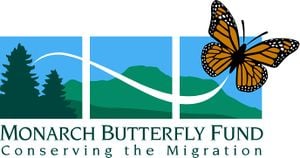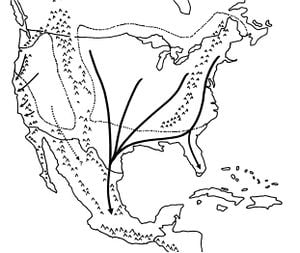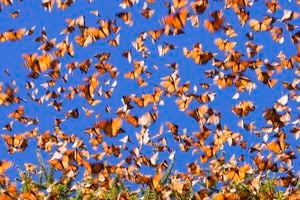
In 2009, the Michoacan Resforestation Fund (MRF) and the Monarch Butterfly Sanctuary Foundation (MBSF) merged together to create The Monarch Butterfly Fund. The Monarch Butterfly Fund seeks to successfully maintain the population of North American Monarch butterflies and their migratory habits through "habitat restoration, research, monitoring, education and support for sustainable community development in and near the monarch overwintering areas in Mexico." There are currently nine members that serve on the board of directors: Karen Oberhauser, Eli Moreno, Lincoln Brower, M.Isabel Ramirez, Don Davis, Chip Taylor, Alfonso Alonso, Gail Morris, and Ernest Williams.[1]
Overview of the Issue

The monarch butterfly is an international traveler. It flies freely between the borders of the United States, Mexico, and Canada. Mexican President Enrique Pena Nieto has said to the president of the United States and prime minister of Canada that "[T]he monarch butterfly [serves] as an emblematic species of North America which unites our three countries." But as of recent, the population of monarch butterfly has been dwindling. In 1996, the number of monarch butterfly was estimated to be around 1.1 billion. But as of 2014, that number has gone down to a mere 33 million. It is now an internationally recognized problem, and the leaders of all three nations are looking for ways to restore the monarch butterfly population.[2]
In the United States, the main cause for the decrease in monarch butterfly populations has to do with the use of a herbicide named glyphosate — or Roundup as it's known commercially. The use of this weed killer has led to the destruction of the monarch caterpillars' sole source of food: milkweed. [3] One proposed solution put forth by Monarch Watch director Chip Taylor, is to regulate the use of the pesticide used to kill milkweed and to create a "milkweed corridor" that runs through the heart of the United States from Canada to the Mexican border. [4]
Monarchs in Mexico

Over the winter, monarch butterflies migrate south to the Mariposa Monarca Biosphere Reserve located in central Mexico. Some monarch butterfly have been recorded to travel as much as 3,000 miles.[5] The Mariposa Monarca Biosphere Reserve covers over 56,000 hectares, however, with the dwindling number of monarch butterflies around today, only a tiny portion of the reserve is actually used by butterflies.[6] Still, the reserve is threatened by illegal logging. It is especially hard to stop illegal loggers since the location of instances where illegal logging takes place are remote for authorities to arrive in time. The deforestation of the reserve allows for cold winds to reach the resting monarchs and death from freezing becomes a possibility. [7]
Goals of the Fund
The Monarch Butterfly Fund aims to help the North American population of monarch butterflies return to normal by using a three pronged approach to the problem.
- Education & Outreach The organization teaches local citizens of the region to become "eco-tour guides." An eco-tour guide shows visitors the hard work that goes into conserving the fragile environment where the monarch butterfly hibernates. The fund hosts workshops that give citizens the opportunity to learn about the monarch's basic biology and the transnational migratory route it takes to get to the Monarch Butterfly Reserve. Every year, a festival called the Monarch Butterfly Festival is put on by the fund for the local school children of the region. [8]
- Scientific Research In 2011 the fund started a project to look into the effects different soils have on saplings that were to be planted in the reserve. Students from universities around Mexico often come to the reserve to help out with the fund's research endeavors.
- Forest Conservation The forests of the region are important for both the locals and monarch butterflies. In 2013 the fund planted 37,730 pines , 1,000 oyamels, and 1,280 oaks in nine different areas within the Monarch Butterfly Biosphere Reserve. In 2011 the fund teamed up with a Californian non-profit to employ two groups of indigenous residents living within the reserve to undertake a similar task of planting thousands of trees.
References
- History of the Monarch Butterfly Fund http://www.monarchbutterflyfund.org/node/123
- "NAFTA leaders agree to protect monarch butterfly," The Star, 02/20/2014 http://www.thestar.com/news/world/2014/02/20/nafta_leaders_agree_to_protect_monarch_butterfly.html
- "Limits sought on weed killer glyphosate to help monarch butterflies," Los Angeles Times,02/25/2014 http://www.latimes.com/science/sciencenow/la-sci-sn-monarch-butterfly-roundup-20140224,0,1342942.story#ixzz2uOWK154n
- Monarch Watch: Monarch Butterfly Recovery Plan http://monarchwatch.org/blog/2014/03/monarch-butterfly-recovery-plan/
- US Fish and Wildlife Services: International Affairs Division - The Monarch Butterfly https://www.fws.gov/international/animals/monarch-butterfly.html
- United Nations World Heritage Site: Monarch Butterfly Reserve http://whc.unesco.org/en/list/1290
- Tala clandestina afecta a mariposa monarca http://www.eluniversal.com.mx/sociedad/2014/impreso/tala-clandestina-afecta-a-mariposa-monarca-profepa-9521.html
- World Wildlife Foundation http://worldwildlife.org/stories/protecting-monarch-butterflies-and-their-forests